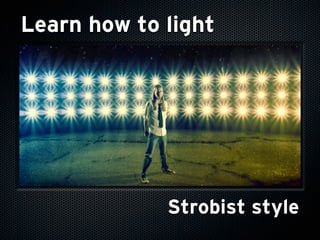Learn how to light, strobist style
- 1. Learn how to light Strobist style
- 3. Learning how to use off-camera flash with your dSLR to take your photos to the next level. Or the next ten levels. David Hobby, strobist.com
- 4. strobist.com
- 5. David Hobby a 20-year career newspaper shooter. Baltimore, Washington DC based
- 6. Why would I strobist?
- 7. Why would I strobist? Smal kit No more power outlets Fast to assemble
- 8. How to trigger your flash off-camera Cables Optical slave Infrared Radiosignal
- 9. Cables Pros Reliable No line of sight Cons Fragile Limited in range Can spoil your image
- 10. Infrared Pros Settings on camera High speed flashing Cons Limited to one brand Limited in broad daylight Line of sight needed
- 11. Optical slaves Pros No extra components Cons needs master light Limited in range Needs Line of sight
- 12. Radio Triggers Pros Reliable No line of sight No problems with Cons More expensive All manual
- 13. Cactus triggers Pros very cheap small Cons 1/5 misfires fragile battery operated
- 14. Pocket wizards Pros Reliable Great distance Cons Expensive Big
- 15. How does light work?
- 16. How to work with light Light travels in straight lines Light works best at an angle Shadows are part of light
- 17. Light modifiers
- 18. Light modifiers bare flash
- 19. Light modifiers bare flash one gobo
- 20. Light modifiers bare flash one gobo two gobos
- 21. Light modifiers bare flash one gobo two gobos snoot
- 22. Light modifiers bare flash one gobo two gobos snoot short snoot
- 23. Light modifiers bare flash one gobo two gobos snoot short snoot medium snoot
- 24. Light modifiers bare flash one gobo two gobos snoot short snoot medium snoot long snoot
- 25. Light modifiers bare flash one gobo two gobos snoot short snoot medium snoot long snoot grid
- 26. Umbrellas and softboxes Diffuse light Mimics the sun Shoot through or reflective
- 27. The sky is the limit
- 28. Ambient light + flash
- 29. Photos under CC license by: Rupert German (flickr.com/photos/rupert-germann): setup shot Mariano Kamp (flickr.com/photos/mkamp): chess shot e-magic (flickr.com/photos/ emagic): cable guy Michael Jones (flickr.com/photos/chealion): pocketwizard Ragnar Jensen (flickr.com/photos/ragnar1984): strobistsmurf Andy Gock (flickr.com/photos/andygock): cactus triggers Philgarlic (flickr.com/photos/philgarlick): red filter Jon Iraundegi (flickr.com/photos/joniraundegi): radio Patrick Brosset (flickr.com/photos/gnackgnackgnack): light Steven Wampler (flickr.com/photos/sgw): light modifiers Tio (flickr.com/photos/66179962@N00): studio flash Nick Wheeler (flickr.com/photos/nickwheeleroz): umbrella shot Myself
- 30. Filip Bunkens info@pitslamp.be http://www.pitslamp.be http://www.twitter.com/bunker






























